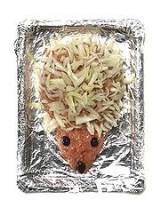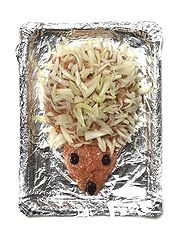
Mett
Encyclopedia

Pork
Pork is the culinary name for meat from the domestic pig , which is eaten in many countries. It is one of the most commonly consumed meats worldwide, with evidence of pig husbandry dating back to 5000 BC....
that is popular in Germany
Germany
Germany , officially the Federal Republic of Germany , is a federal parliamentary republic in Europe. The country consists of 16 states while the capital and largest city is Berlin. Germany covers an area of 357,021 km2 and has a largely temperate seasonal climate...
.
Description
The name is derived from Low German mett for "chopped pork meat without bacon", or Old Saxon meti for "food". It also known as Hackepeter (20th century jargon, Northern GermanyNorthern Germany
- Geography :The key terrain features of North Germany are the marshes along the coastline of the North Sea and Baltic Sea, and the geest and heaths inland. Also prominent are the low hills of the Baltic Uplands, the ground moraines, end moraines, sandur, glacial valleys, bogs, and Luch...
and Berlin
Berlin
Berlin is the capital city of Germany and is one of the 16 states of Germany. With a population of 3.45 million people, Berlin is Germany's largest city. It is the second most populous city proper and the seventh most populous urban area in the European Union...
). It consists of minced pork meat, normally sold or served seasoned with salt
Salt
In chemistry, salts are ionic compounds that result from the neutralization reaction of an acid and a base. They are composed of cations and anions so that the product is electrically neutral...
and black pepper
Black pepper
Black pepper is a flowering vine in the family Piperaceae, cultivated for its fruit, which is usually dried and used as a spice and seasoning. The fruit, known as a peppercorn when dried, is approximately in diameter, dark red when fully mature, and, like all drupes, contains a single seed...
, regionally also with garlic
Garlic
Allium sativum, commonly known as garlic, is a species in the onion genus, Allium. Its close relatives include the onion, shallot, leek, chive, and rakkyo. Dating back over 6,000 years, garlic is native to central Asia, and has long been a staple in the Mediterranean region, as well as a frequent...
or caraway
Caraway
Caraway also known as meridian fennel, or Persian cumin is a biennial plant in the family Apiaceae, native to western Asia, Europe and Northern Africa....
, and eaten raw. It is also permitted to add chopped onion
Onion
The onion , also known as the bulb onion, common onion and garden onion, is the most widely cultivated species of the genus Allium. The genus Allium also contains a number of other species variously referred to as onions and cultivated for food, such as the Japanese bunching onion The onion...
, in which case it is known as Zwiebelmett (onion Mett). Legally, German Mett is not allowed to contain more than 35% fat. Unless pre-packaged, the German Hackfleischverordnung ("minced meat directive") permits mett to be sold only on the day of production.
Varieties
Schinkenmett ("ham Mett"), prepared from the upper thigh (ham), is considered especially fine.In contrast to the normally available locally minced Mett, coarse pork Mett (Grobes Schweinemett) is produced in an industrial meat grinder. To preserve its structure, the pork meat is normally processed in a semi-frozen state. The "minced meat directive" does not permit temperatures over 2°C; ice may not be used for cooling.
Serving styles
Raw Mett is normally eaten on bread rolls (Mettbrötchen) or sliced bread, frequently with a garnish of raw onion rings or diced raw onion.At buffets, Mett is occasionally served as a Mettigel (Mett hedgehog, also Hackepeterigel or Hackepeterschwein). This form of serving Mett was especially popular in the 1970s. To produce it, a large amount of Mett is shaped as a hedgehog, quartered onion rings or pretzel
Pretzel
A pretzel is a type of baked food made from dough in soft and hard varieties and savory or sweet flavors in a unique knot-like shape, originating in Europe...
sticks are used as spikes, olives as eyes and nose.
Sausage
Mett can be made more durable in the form of MettwurstMettwurst
Mettwurst is a strongly flavoured German sausage made from raw minced pork, which is preserved by curing and smoking. The southern German variety is soft and similar to Teewurst. Braunschweiger mettwurst is smoked somewhat but still soft and spreadable, while other northern German varieties such...
, a spicy and frequently smoked raw sausage
Sausage
A sausage is a food usually made from ground meat , mixed with salt, herbs, and other spices, although vegetarian sausages are available. The word sausage is derived from Old French saussiche, from the Latin word salsus, meaning salted.Typically, a sausage is formed in a casing traditionally made...
.

